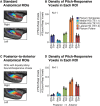Pitch-Responsive Cortical Regions in Congenital Amusia
- PMID: 26961952
- PMCID: PMC6601753
- DOI: 10.1523/JNEUROSCI.2705-15.2016
Pitch-Responsive Cortical Regions in Congenital Amusia
Abstract
Congenital amusia is a lifelong deficit in music perception thought to reflect an underlying impairment in the perception and memory of pitch. The neural basis of amusic impairments is actively debated. Some prior studies have suggested that amusia stems from impaired connectivity between auditory and frontal cortex. However, it remains possible that impairments in pitch coding within auditory cortex also contribute to the disorder, in part because prior studies have not measured responses from the cortical regions most implicated in pitch perception in normal individuals. We addressed this question by measuring fMRI responses in 11 subjects with amusia and 11 age- and education-matched controls to a stimulus contrast that reliably identifies pitch-responsive regions in normal individuals: harmonic tones versus frequency-matched noise. Our findings demonstrate that amusic individuals with a substantial pitch perception deficit exhibit clusters of pitch-responsive voxels that are comparable in extent, selectivity, and anatomical location to those of control participants. We discuss possible explanations for why amusics might be impaired at perceiving pitch relations despite exhibiting normal fMRI responses to pitch in their auditory cortex: (1) individual neurons within the pitch-responsive region might exhibit abnormal tuning or temporal coding not detectable with fMRI, (2) anatomical tracts that link pitch-responsive regions to other brain areas (e.g., frontal cortex) might be altered, and (3) cortical regions outside of pitch-responsive cortex might be abnormal. The ability to identify pitch-responsive regions in individual amusic subjects will make it possible to ask more precise questions about their role in amusia in future work.
Keywords: amusia; auditory cortex; fMRI; music; pitch.
Copyright © 2016 the authors 0270-6474/16/362986-09$15.00/0.
Figures




References
Publication types
MeSH terms
Substances
Supplementary concepts
LinkOut - more resources
Full Text Sources
Other Literature Sources
